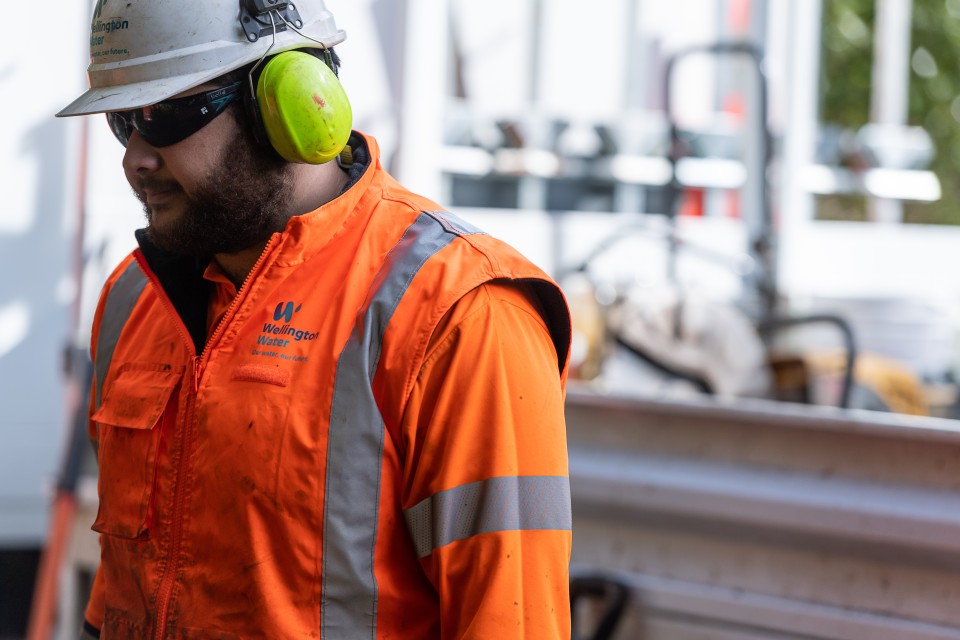Network Overflows
Wellington region’s wastewater system is ageing, and parts of the network are over 120 years. When the wastewater network was originally constructed, it was designed around protecting public health, with less focus on the health of the environment.
The network transfers as much as it physically can to treatment plants, up to five times the normal daily average flows. However, when the network gets overloaded, some wastewater can overflow from manhole lids and at constructed outlet pipes into streams, rivers, and the harbour. These overflows, minimise the risk of wastewater entering your property and community and reduce the risks to public health.
Overflows also happen where stormwater pipes are incorrectly connected to a wastewater pipe. These cross connections can cause the wastewater network to overflow during heavy rainfall, spilling untreated wastewater into the environment.
Wellington Water recommends all recreational water users follow the advice of Land, Air, Water Aotearoa (LAWA) - https://www.lawa.org.nz/explore-data/swimming/
What we are doing to reduce network overflows
In partnership with our client councils, mana whenua iwi, and through community input, we are taking a catchment-wide approach to identify and address network overflows and reduce the impact on the environment where we can. This new approach follows resource consents that were recently lodged with Greater Wellington Regional Council.
Throughout the region, our council owners are investing in multi-million-dollar projects such as the Porirua Central Wastewater Storage Tank currently under construction. In the Wellington CBD [Taranaki Street] we are increasing network capacity, while in the Hutt Valley, we are increasing the resilience of the wastewater network with a variety of projects. In addition, Wellington Water is also inspecting property connections to reduce the source of wet weather overloading.
Read our Wastewater page to find out what you can do to prevent wastewater overflows and help take care of the region’s wastewater network and protect the environment.
Network Overflows Reporting
Where we can, we report overflows from the wastewater network during heavy rainfall on a monthly basis.
The data provided below reflects network overflows recorded at selected and monitored sites across the Wellington metropolitan region only. They are not representative of all network overflows during wet weather events.
We are working on providing the public with further data on overflows, which will require additional resources to verify the accuracy of this information before we can publish it.
We acknowledge these events are of public interest. We are committed to being open and transparent in letting you know when they occur. We are working to improve our systems for the reporting of all network overflows and to ensure the data accuracy and integrity for more comprehensive reporting over time.
June 2024
| Previous week | 0 |
| Last month | 1 |
| This financial year (since 1/7/2023) | 158 |
May 2024
| Previous week | 4 |
| Last month | 30 |
| This financial year (since 1/7/2023) | 157 |
April 2024
| Previous week | 1 |
| Last month | 7 |
| This financial year (since 1/7/2023) | 139 |
March 2024
| Previous week | 2 |
| Last month | 5 |
| This financial year (since 1/7/2023) | 120 |
February 2024
| Previous week | 0 |
| Last month | 7 |
| This financial year (since 1/7/2023) | 115 |
January 2024
| Previous week | 3 |
| Last month | 17 |
| This financial year (since 1/7/2023) | 107 |
December 2023
| Previous week | 10 |
| Last month | 7 |
| This financial year (since (1/7/2023) | 98 |
November 2023
| Previous week | 3 |
| Last month | 16 |
| This financial year (since (1/7/2023) | 85 |
Overflows broken down by council area
| Hutt City Council | 38 |
| Porirua City Council | 7 |
| Upper Hutt City Council | 0 |
| Wellington City Council | 113 |
This page was last updated on: 15/07/24
*Treatment plant discharges are reported separately. We publish those monthly on our website and on social media channels
Is it safe to swim?
It is recommended you do not swim for two days following a heavy rainfall event. This is to not only protect you from wastewater overflows, but also other contaminants from stormwater that wash off the roads.
For the latest on swimming in your area, head to LAWA

